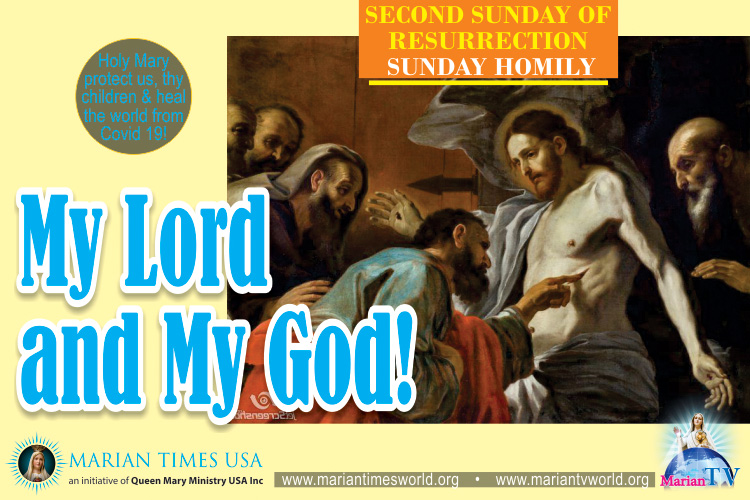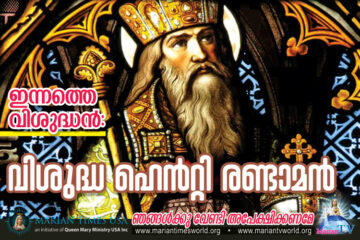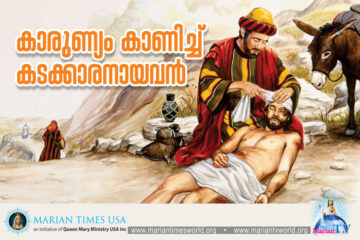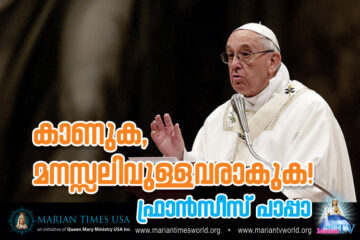MY LORD AND MY GOD! (Sunday Homily)


~ Fr. Abraham Mutholath ~
Chicago, USA. ~
SUNDAY HOMILY – SECOND SUNDAY OF RESURRECTION
INTRODUCTION
The persistence of St. Thomas the Apostle that he would believe in the Risen Lord only if he would see Jesus personally and touch the wound-marks on his hands and side became another proof for the resurrection of Jesus. Jesus is the focus of the story because he, who washed the feet of his apostles, humbled to appear before Thomas and obliged to all his demands to make him come back to his faith. Thomas in return expressed his firm belief in the Risen Lord and committed himself for the spreading of the gospel and even became a martyr in AD 72. Today being the feast of Divine Mercy, let us express our trust in the Lord, seek his mercy for our sins and the sins of the world, and show mercy to all whom we encounter.
BIBLE TEXT
Appearance to the Disciples.
(19) On the evening of that first day of the week, when the doors were locked, where the disciples were, for fear of the Jews, Jesus came and stood in their midst and said to them, “Peace be with you.” (20) When he had said this, he showed them his hands and his side. The disciples rejoiced when they saw the Lord. (21) [Jesus] said to them again, “Peace be with you. As the Father has sent me, so I send you.” (22) And when he had said this, he breathed on them and said to them, “Receive the holy Spirit. (23) Whose sins you forgive are forgiven them, and whose sins you retain are retained.”
Thomas.
(24) Thomas, called Didymus, one of the Twelve, was not with them when Jesus came. (25) So the other disciples said to him, “We have seen the Lord.” But he said to them, “Unless I see the mark of the nails in his hands and put my finger into the nail marks and put my hand into his side, I will not believe.” (26) Now a week later his disciples were again inside and Thomas was with them. Jesus came, although the doors were locked, and stood in their midst and said, “Peace be with you.” (27) Then he said to Thomas, “Put your finger here and see my hands, and bring your hand and put it into my side, and do not be unbelieving, but believe.” (28) Thomas answered and said to him, “My Lord and my God!” (29) Jesus said to him, “Have you come to believe because you have seen me? Blessed are those who have not seen and have believed.”
INTERPRETATION
Appearance to the Disciples.
(19) On the evening of that first day of the week, when the doors were locked, where the disciples were, for fear of the Jews, Jesus came and stood in their midst and said to them, “Peace be with you.”
First day of the week
Since God created the universe and everything in it within six days and sanctified the seventh day as Sabbath, the next day was considered as a new beginning. The resurrection of Jesus on the Sunday early morning was the beginning of a new era. Jesus continued to appear on Sundays to his disciples until he ascended into heaven. Hence for Christians, Sunday replaced the sabbath day.
When the doors were locked
The body of the Risen Lord was his same body when he was alive but had changed the limitations of the physical body. So, he could come inside the locked room through the wall without opening the doors. This is an indication of the nature of our risen body at the second coming of Christ.
For fear of the Jews
The Jewish leaders were watchful of the disciples of Jesus. The chief priestsand Pharisees were afraid that the disciples might steal the body of Jesus and claim that he had resurrected from the dead (Mathew 27:62-66). Peter had cut off the ear of the high priest’s slave with sword (John 18:10) and John was at the foot of the cross. They and other disciples could be under monitoring by the Jewish authorities.
“Peace be with you.”
This was a usual form of salutation among the Jews. Israel had peace and prosperity when they were faithful to God.
Jesus appeared to his disciples after the successful offering of himself as the Lamb of God similar to the return of the high priest from the holy of holies on the Day of Atonement (Leviticus 16:34). On the Yom Kippur or Day of Atonement each year, the high priest used to go into the holy of holies and sprinkle the mercy seat with the blood of a bull for the purification of the priests and the blood of a goat for the forgiveness of sins of all Israelites. Jesus, the Lamb of God, had sacrificed himself as the perfect sacrifice for the forgiveness of sins of all who turn to him in faith. Thus, peace was established and Jesus was communicating that to the world through his apostles.
(20) When he had said this, he showed them his hands and his side. The disciples rejoiced when they saw the Lord.
He showed them his hands and his side
Even without the disciples asking for proof, Jesus showed them the wound marks on his hands and chest. They were the permanent marks of his great love. The apostles were more convinced of the resurrection of the Lord. Some of them had only reports of the vision of the resurrected Lord. They had now seen the Risen Lord in person.
The disciples rejoiced when they saw the Lord.
Jesus appeared unexpectedly to the disciples. Their conviction that he was real and not a ghost, turned their grief at the loss of Jesus to the joy of his victory.
(21) [Jesus] said to them again, “Peace be with you. As the Father has sent me, so I send you.”
Peace be with you
Unlike the same greeting in John20:19, this repeated greeting of Jesuswas an assurance he was offering to his apostles as he was sending them out with a mission to the world. In John 14:27, Jesus had assured his disciples, “Peace I leave with you; my peace I give to you. Not as the world gives do I give it to you. Do not let your hearts be troubled or afraid.” Even during severe persecution, they would experience peace of mind as he himself had during his passion and crucifixion.
As the Father has sent me, so I send you.
During his prayer for his disciples, Jesus had said, “As you sent me into the world, so I sent them into the world.” (John 17:18). He was using the same to address his apostles. Like the Father sent the son with a mission into the world, the son was sending his trained and ordained disciples to continue his mission in the world.Just as the Father needed the service of the Son to communicate his message of love and redemption in words and action, Jesus needed the church to continue the same in this world. As the members of the church, we are the missionaries of Jesus to proclaim his gospel in our day today lives.
(22) And when he had said this, he breathed on them and said to them, “Receive the holy Spirit.
He breathed on them
The breathing of Jesus on his disciples was equivalent to God breathed into the nostril of Adam when he was made from clay (Genesis 2:7). Unlike the case of other living beings, God breathed into Adam’s body that He carefully crafted from clay. This breathing gave Adam an everlasting soul. Similar breathing of Jesus on the apostles was to give them a new spiritual life. This was fulfilled by the coming of the Holy Spirit on the Day of Pentecost. We are all created anew when we received the Baptism of Jesus. That was the fulfillment of Jesus instructing Nicodemus that “no one can enter the kingdom of God without being born of water and Spirit.” (John 3:5).
Receive the holy Spirit.
At the last supper, Jesus gave the consecrated bread and wine and told the apostles to receive his body and blood. At this moment, he asked them to receive the Holy Spirit as the continuation and fulfillment of the Holy Eucharist.
(23) Whose sins you forgive are forgiven them, and whose sins you retain are retained.
Whose sins you forgive are forgiven them
God the Father had commissioned Jesus to save the people who are sinners. Jesus in turn commissioned his disciples to do the same. So, their mission was not to condemn the world but to save it through their preaching, baptism and absolution of sins. They received the authority to do so when they received the Holy Spirit that empowered them with the Grace of God.
Whose sins you retain are retained
Repentance is a requirement for the forgiveness of sins. In the story of the prodigal son, the Father had been patiently waiting for the return of his younger son with true repentance. Jesus absolved the sins of all who approached him with contrite hearts, including one of the criminals crucified with him. The sins retained are the iniquities of those who do not compromise with God.
(24) Thomas, called Didymus, one of the Twelve, was not with them when Jesus came.
Thomas, called Didymus
Thomas is a Hebrew name and Didymus a Greek name. Both the names signify twin because Thomas was one of the twins in his family. Jews used to have a Jewish name and a gentile name. In Judea, they were known by their Hebrew name and in Galilee and other non-Jewish areas they were called by their gentile name. Saul and Paul of the Apostle Paul is an example.
One of the Twelve
Jesus kept many of the Jewish traditions and one of them was the importance he gave to the number 12 in selecting his apostles. They were representative of the 12 tribes of Israel. After the death of Judas, the college of the apostles was very particular to maintain the 12 by selecting Mathias substituting Judas.
The importance of the number 12 which was considered as one of the perfect numbers like 3, 7, and 10 derived from the 12 sons of Jacob whose descendants became the 12 tribes of Israel. Moses sent 12 spies to Canaan representing the 12 tribes of Israel. Jesus considered his church as the new Israel and selected 12 men as the pillars of his church. He said of his apostles, “Amen, I say to you that you who have followed me, in the new age, when the Son of Man is seated on his throne of glory, will yourselves sit on twelve thrones, judging the twelve tribes of Israel.” (Mathew 19:28).
Thomas was not with them when Jesus came
It was not Judas or Peter alone who failed in their promises at the passion of Christ. Thomas who had boldly told his colleagues “Let us also go to die with him” (John 11:16) had failed when the death of Jesus happened. However, he sacrificed his life for Jesus in 72AD. Thomas might have been suffering from guilt feeling that he like Peter did not keep his promise. Thomas might have opted to grieve in private like some people would like to spend in solitude during the time of severe grief than in the companionship of others. He might not have remembered the words of Jesus, “For where two or three are gathered together in my name, there am I in the midst of them.” (Mathew 18:20).
(25) So the other disciples said to him, “We have seen the Lord.” But he said to them, “Unless I see the mark of the nails in his hands and put my finger into the nail marks and put my hand into his side, I will not believe.”
The unbelief of Thomas was not just his refusal to believe in the testimony of his ten colleagues, but in the resurrection of Jesus. Seeing was not enough for Thomas. He wanted to touch and feel the wound marks on the body of Jesus.
Nail marks
Crucifixion of criminals could be by nailing or fastening to the cross with cords. The words of St. Thomas were a proof that Jesus was nailed to the cross. That was also the fulfillment of Psalm 22:17, “They have pierced my hands and my feet.”
Put my hand into his side
Thomas knew that the heart of Jesus was pierced though he did not see it. Probably he came to know that from the eyewitness account of John.
(26) Now a week later his disciples were again inside and Thomas was with them. Jesus came, although the doors were locked, and stood in their midst and said, “Peace be with you.”
This second appearance of Jesus while Thomas was present among the disciples was the Sunday after Easter. Though apostles might have been gathering often, this Sunday gathering might have been for special prayer in remembrance of the resurrection of the Lord. This time also, as in the past week, the doors were locked for fear of Jews when Jesus appeared to them. Probably they might have been in the same room. The same greeting of Jesus as before, “Peace be unto you,” was a normal greeting with a new meaning of the peace of resurrection added to it.
Thomas was with them
Thomas might have realized that he should be with the company of other apostles to receive the privilege to meet the Risen Lord. So, he continued staying with them in prayer. The other 10 apostles were witnesses to the privilege Jesus gave to Thomas to touch his wounds of crucifixion.
(27) Then he said to Thomas, “Put your finger here and see my hands, and bring your hand and put it into my side, and do not be unbelieving, but believe.”
During the previous Sunday, Thomas missed the visit of Jesus and all that Jesus did for the other apostles. However, during the second Sunday, Thomas got special attention from Jesus by calling him by name and allowing him to touch his healed wounds from crucifixion.
Do not be unbelieving, but believe
This could mean the unbelief of Thomas in the resurrection of Jesus as well as his tendency to move backward in his spiritual relation with Jesus. A firm believer trusts the Lord without seeking evidences.
(28) Thomas answered and said to him, “My Lord and my God!”
Thomas might have been surprised that the Master had known his intentions without telling Jesus his demand and that his Lord was humbling himself to appear before him and yielded to his demands. Without waiting to touch for belief, Thomas responds immediately professing his faith.
“My Lord and my God!”
There are different shades of meaning for the words “Lord” and “God.” The term God comes from Hebrew “Elohim” and Greek “Theos.”God stands for the all-powerful one who created the world and sustains it. The word “Lord” comes from Hebrew “Adonai” and Greek “Kurios”. It is also translated as Yahweh (Jehovah), who interacts with people like making Adam out of clay, conversing with first parents, and making covenant with the people. Elohim came from Priestly tradition and Yahweh came from Yahwistic tradition in the Bible. Thus, Old Testament used both Lord and God when referring to God the almighty. Psalm 35:23 uses, “my God and my Lord.”
Jesus was usually called as Lord by his disciples. The Lord could mean someone in higher rank or the “Son of God.” In Mathew 16:16, Simon Peter answered Jesus, “You are the Christ, the Son of the living God.” Jesus had asserted that he was God and that was why he was accused of blasphemy. However, it was Thomas who was inspired to say to the Risen Lord, “My Lord and my God.” By that, Thomas declared that he had seen Jesus so far, as his Lord. However, he acknowledged that the Lord was also the mighty God. Hence, Thomas had advanced in his belief and conviction. He expressed his faith in the divinity of Jesus.Jesus had told in John 14:9, “Anyone who has seen me has seen the Father.” Thomas while seeing the Risen Lord acknowledged that the God the Father was visible in Jesus.
(29) Jesus said to him, “Have you come to believe because you have seen me? Blessed are those who have not seen and have believed.”
We believe many things in practical and spiritual life without physically seeing or proving. We trust in the words or report of others. Jesus compliments those who believe with spiritual sight than with physical sight.
The doubt of Thomas and Jesus yielding to the demand of Thomas became another clear proof for the resurrection of Jesus.
MESSAGE OF DIVINE MERCY
Today is also Divine Mercy Sunday. This devotion to Jesus emerged from the visions of a Polish nun, Sr. Maria Faustina Kowalska who was born on August 25, 1905 and died on October 5, 1938. She had a vision of Jesus on February 22, 1931 and Jesus had asked her to paint his image as she had seen in the vision. The painting of Divine Mercy was completed in June 1934 with the help of an artist. Sr. Faustina had messages from Jesus from 1931 to 1938. The message of the Divine Mercy was a great comfort for the victims of Second World War. Pope John Paul II issued an encyclical on the Divine Mercy on November 30, 1980. Pope John Paul II canonized Sr. Faustina and proclaimed the celebration of Divine Mercy Sunday on April 30, 2000. This feast is celebrated every year on the second Sunday of Easter based on the message of Jesus to Sr. Faustina.
The Divine Mercy gives us three themes:
- To ask for and obtain the mercy of God
- To trust in Christ’s abundant mercy
- To show mercy to others and act as a channel for God’s mercy towards them.
The five main forms of Divine Mercy devotion are:
- The Divine Mercy image with the specific inscription, “Jesus, I trust in you.”
- The celebration of the Feast of the Divine Mercy Sunday.
- The recital of the Chaplet of Divine Mercy.
- The designation of the Hour of Mercy at 3:00 P.M.
- The spreading of acts of mercy to the whole world, in preparation for the second coming of Christ.
The image of Divine Mercy depicts Jesus standing with one hand outstretched for blessing, the other grasping the heart that was pierced while Jesus was crucified. From the broken heart proceeds two beams of red and white light. The two colors represent blood and water that flowed from the heart of Jesus when his heart was pierced. The water stands for baptism and the blood for Holy Eucharist that we have received for our salvation.
Jesus hadtaught us the mercy of his Father and had shown mercy during his life on earth. He showed mercy to St. Thomas who was in grief of missing to see the Risen Lord. Jesus conveyed his special love toward the modern world through the visions and messages to Sister St. Faustina. Let us trust in the Lord and seek his mercy, and involve in acts of mercy.
Message
- Jesus used to appear every Sunday to his disciples after his resurrection and before his ascension into heaven. Jesus comes down to meet us in the sacramental way during every Holy Mass, especially on Sundays. Let us give proper importance for Sunday observance including the partaking of the sacrifice of Jesus and sharing of our sacrificial love and service to our family and fellow humans who need our care.
- Since Thomas did not keep the company of his fellow apostles, he missed the golden opportunity to meet the Risen Lord on the actual day of resurrection. While he was absent, Jesus breathed on other apostles and commissioned them for spreading the gospel and empowered them to forgive and abstain sins. Though he got all these later from Jesus in person, the experience of Thomas is a lesson for us to keep up the Christian brotherhood and companionship.
- Compassion of Jesus to St. Thomas who was stubborn in his approach is also a lesson for us. Jesus who washed the feet of his disciples demonstrated to the disciples how we could be humble and caring towards people who are tough to handle.
- The story of Thomas missing the first appearance of Jesus to the apostles on Easter Sunday gives us a lesson. Some believers claim that they want to be spiritual but don’t want to do anything with religion. They have faith in God and do personal prayers. Jesus wants us to be in communion with the church because he is the head of the church and the Holy Spirit is guiding the church. The Holy Mass, which is the sacrifice of Jesus, and other sacraments are our essential spiritual nourishments.
- The experience of St. Thomas and the messages of Divine Mercy through Sister St. Faustina are messages to trust in the Lord, to seek the mercy of God, and communicate and show mercy to others in our daily lives.
- Both the experience of St. Thomas seeing the Risen Lord and the vision of Jesus to St. Faustina point to the wounded heart of Jesus. His sacrificial love from his heart is a lesson for us to follow in serving others from our hearts.
മരിയന് ടൈംസിലെ ഇന്നത്തെ പ്രധാനപ്പെട്ട അപ്ഡേറ്റുകള് താഴെ ലഭിക്കുന്നതാണ്.









